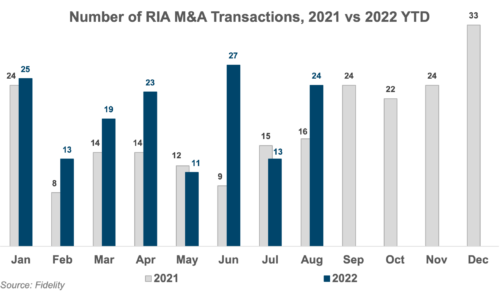RIA M&A Update
Year-to-date RIA M&A activity has surpassed last year’s record levels in 2022, even as macro headwinds for the industry continue to mount. Fidelity’s August 2022 Wealth Management M&A Transaction Report listed 155 deals through August of 2022, up from 112 during the same period in 2021. These transactions represented $212 billion in AUM, up 16% from 2021 levels.

The continued strength of RIA M&A activity amidst the current environment dominated by inflation, rising interest rates, and a tight labor market is noteworthy, given that all these factors could strain the supply and demand dynamics that have driven deal activity in recent years. Rising costs and interest rates coupled with a declining fee base will put pressure on highly leveraged consolidator models, and a potential downturn in performance could put some sellers on the sidelines until fundamentals improve.
But despite these pressures, the market has proven robust (at least so far). Demand for RIAs has remained strong, with professionalization of the buyer market continuing to be a theme driving M&A activity. Serial acquirers and aggregators increasingly drive deal volume with dedicated deal teams and access to capital. Mariner, CAPTRUST, Beacon Pointe, Mercer Advisors, Creative Planning, Wealth Enhancement Group, Focus Financial, and CI Financial all completed multiple deals during the first eight months of the year.
While the current market environment has prompted some serial acquirers to temper their pace of acquisition activity (CI Financial’s CEO Kurt McAlpine remarked on the company’s first-quarter earnings call that their pace of acquisitions has “absolutely slowed down”), we’ve not yet seen that borne out in reported deal volume. Multiples in the industry remain high, although the upward trend in multiples has reportedly leveled off.
On the supply side, the current market environment is likely to have a mixed impact on bringing sellers to market. On one hand, some sellers may be reluctant to sell when the markets (and their firm’s financial performance) are down significantly from their peak. On the other hand, a concern that multiples may decline if the current market environment persists may prompt some sellers to seek an exit while multiples remain relatively robust.
The current market environment is likely to have a mixed impact on bringing sellers to market
While market conditions play a role in exit timing, the motives for sellers often encompass more than purely financial considerations. Sellers are often looking to solve for succession issues, improve quality of life, and access organic growth strategies. Such deal rationales are not sensitive to the market environment and will likely continue to fuel the M&A pipeline even in a downturn. And despite years of record-setting M&A activity, the number of RIAs continues to grow—which suggests the uptick in M&A activity is far from played out.
What Does This Mean for Your RIA?
For RIAs planning to grow through strategic acquisitions: Pricing for RIAs has trended upwards in recent years, leaving you more exposed to underperformance. While the impact of current macro conditions on RIA deal volume and multiples remains to be fully seen, structural developments in the industry and the proliferation of capital availability and acquirer models will likely continue to support higher multiples than the industry has in the past. That said, a long-term investment horizon is the greatest hedge against valuation risks. Short-term volatility aside, RIAs continue to be the ultimate growth and yield strategy for strategic buyers looking to grow their practice or investors capable of long-term holding periods. RIAs will likely continue to benefit from higher profitability and growth compared to broker-dealer counterparts and other diversified financial institutions.
For RIAs considering internal transactions: We’re often engaged to address valuation issues in internal transaction scenarios. Naturally, valuation considerations are front of mind in internal transactions, as in most transactions. But how the deal is financed is often a crucial secondary consideration in internal transactions where buyers (usually next-gen management) lack the ability or willingness to purchase a substantial portion of the business outright. As the RIA industry has grown, so too has the number of external capital providers who will finance internal transactions. A seller-financed note has traditionally been one of the primary ways to transition ownership to the next generation of owners (and, in some instances, may still be the best option). Still, there are also an increasing number of bank financing and other external capital options that can provide the selling partners with more immediate liquidity and potentially offer the next-gen cheaper financing costs.
If you are an RIA considering selling: Whatever the market conditions when you go to sell, it is essential to have a clear vision of your firm, its value, and what kind of partner you want before you go to market. As the RIA industry has grown, a broad spectrum of buyer profiles has emerged to accommodate different seller motivations and allow for varying levels of autonomy post-transaction. A strategic buyer will likely be interested in acquiring a controlling position in your firm and integrating a significant portion of the business to create scale. At the other end of the spectrum, a sale to a patient capital provider can allow your firm to retain its independence and continue operating with minimal outside interference. Given the wide range of buyer models out there, picking the right buyer type to align with your goals and motivations is a critical decision that can significantly impact personal and career satisfaction after the transaction closes.
 RIA Valuation Insights
RIA Valuation Insights 






